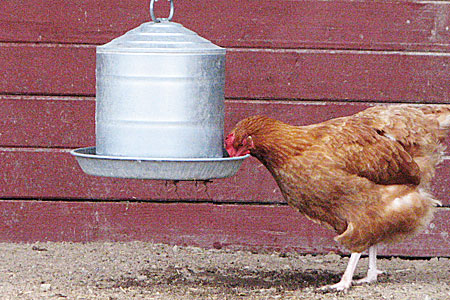
Preventing heat stress in your backyard chicken flock involves a combination of commonsense management measures. The following seven simple strategies will help your chickens stay cool in summer.
Heat Tolerant Breeds
If you live in a climate that’s warm year-around, you might consider keeping a heat tolerant breed. Some chicken breeds naturally tolerate warm weather better than other breeds. Heat tolerant breeds include both large chickens and bantam breeds.
Chicken breeds that are loosely feathered or heavily feathered suffer more in hot weather than lightly feathered breeds, and hens that are laying suffer more than those not in production. Regardless of breed, chickens engage in certain behaviors designed to keep themselves cool in summer. You can help them along by providing the amenities they naturally seek.
Encourage Drinking
When the temperature rises, chickens drink increasingly more water. But if the water is warm, they won’t drink as much as they need. To ensure your chickens get enough to drink, refill the drinker several times a day with cool water.
As an alternative, increase the number of drinkers, taking care to place them where they’ll remain in shade throughout the day. Furnishing multiple drinkers in strategic places will allow your chickens to find water without having to travel far.
Chickens that normally use nipple drinkers may not get enough water during hot weather. Adding hanging drinkers, or shallow pans or bowls of water, gives them alternatives to the nipples. The larger drinkers also allow you the opportunity to place chunks of ice in the drinking water to keep it cool longer.
If you set out pans or bowls of water, you’ll likely find your chickens standing in them to cool their feet and legs. They’ll also poop and foul the water, which therefore needs to be frequently changed for drinking. And a water pan is not such a great idea where baby chicks are involved, as they may get into the water and drown.
Encourage Eating
Chickens eat less in hot weather, and warm temperatures cause rations to go stale faster. Ensure the freshness of feed by purchasing it more often and in smaller quantities. Also, because your hens are eating less, ensure they are getting the appropriate level of nutrition by feeding them a higher protein layer ration.
To encourage chickens to eat in the summer months, turn on coop lights during cooler morning and evening hours. Add extra feeders and distribute them so all chickens can eat at once and none has to travel far to find food.
Offering occasional fresh produce such as peas, blueberries, and strawberries or chunks of apple, banana, or pineapple will give your chickens a welcome treat, encourage them to eat, and provide additional moisture. They’ll also enjoy pecking at a watermelon, cantaloupe, or cucumber cut in half.
Provide Shade
If your coop is portable, move it to a shady area beneath a tree or in the shadow of a taller building. Check to make sure the coop remains in the shade throughout the day.
Outside the coop, provide plenty of shade where the chickens can rest. If necessary, put up an awning or tarp, fastening it so it won’t billow in a breeze and frighten the flock. And don’t let it hang down the sides of the pen, as that would block air circulation.
Circulate Air
Ensure good ventilation inside the coop by opening windows and doors. If you aren’t sure ventilation is adequate, stir up dust by scuffing your foot in the litter. Wait five minutes for the dust to settle. Then look at a light beam coming through a window or use the beam of a strong flashlight to check the air. If dust is still hanging in the air, the coop is not adequately ventilated and would benefit from a ceiling or wall fan to increase air movement.
Fans are sold according to how many cubic feet of air they move per minute (cfm). Look for a fan that provides 5 cfm per chicken. A fan designed for use in your home won’t last long in the dust and humidity generated in the average chicken coop. Fans suitable for agricultural use, called barn fans or agricultural fans, are available at farm stores and rural-oriented builder’s supply outlets, and may be found online.
Eliminate crowded conditions that reduce air circulation by moving some birds to different housing or by expanding their current housing. Do not confine chickens to hot spaces such as trapnests or cages, and especially not in direct sunlight or where ventilation is poor.
Increase Humidity
When the temperature is high and humidity is low, you can take advantage of evaporation to cool birds by frequently hosing down the coop’s outside walls and roof, and by lightly misting adult chickens. Never mist chicks, as they can easily chill. Misting is appropriate only when the following conditions prevail:
- Air temperature is above 95°F.
- Air humidity is below 75%.
- Air circulation is good.
A chicken misting system is easy to set up in the yard, especially if you use a misting kit that comes with all the necessary parts. Such systems, connected to a common garden hose, are designed for misting plants in a green house or cooling a patio. They are available from hardware stores, builder supplies, and online. Turn on the system during the hottest hours (or set it on a timer) and let the chickens choose to mist themselves or not.
Do Not Disturb
During hot weather, chickens typically seek out the coolest place they can find for a midday siesta. Take a cue from your chickens and avoid disturbing them during the heat of the day. They’ll much more appreciate your visits during cooler morning or evening hours.
And that’s today’s news from the Cackle Coop.
Gail Damerow is the author of Storey’s Guide to Raising Chickens.

